 December 2013 Tank of the Month
December 2013 Tank of the Month
December 2013 Tank of the Month
Paolo Piccinelli's (Paolo Piccinell) 340 US-gallon Reef Aquarium
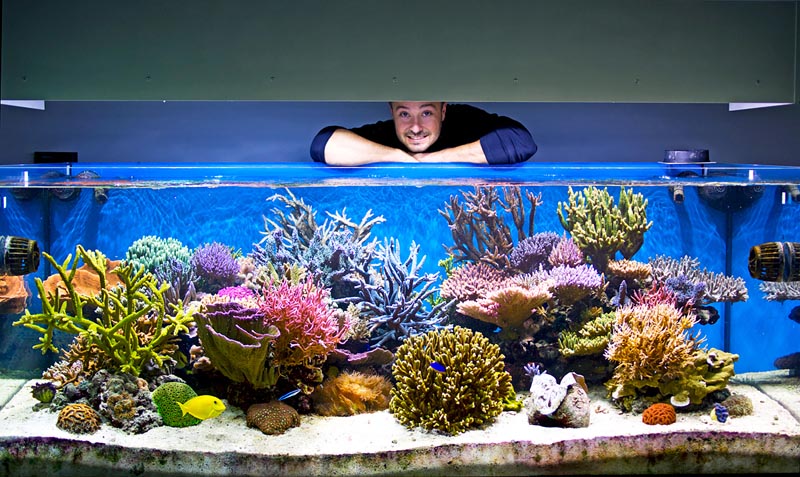 |
Introduction
Hi reefers! It is an unexpected honor to be here and to be able to show you my tank as Tank of the Month! My name is Paolo, I was born 40 years ago in northern Italy where I still live. I am married and a proud father of two beautiful girls; 5 and 3 years old. Since I was a child I have been in love with coral reefs. At that time I had only seen reefs through documentary films and books. When I grew older I had the opportunity to travel and dive in French Polynesia, Egypt, Mauritius, and in the Caribbean. Seeing the amazing beauties of the sea with my bare eyes boosted my passion for the underwater jungle. I could not stay away from it!
In September 2010 I started my first reef aquarium, a 600 litres (150 gallon) aquarium, using the classic berlin method, but immediately I recognized it was not enough. On the first of October 2011 the new tank, this time based on the deep sandbed method, took its place.
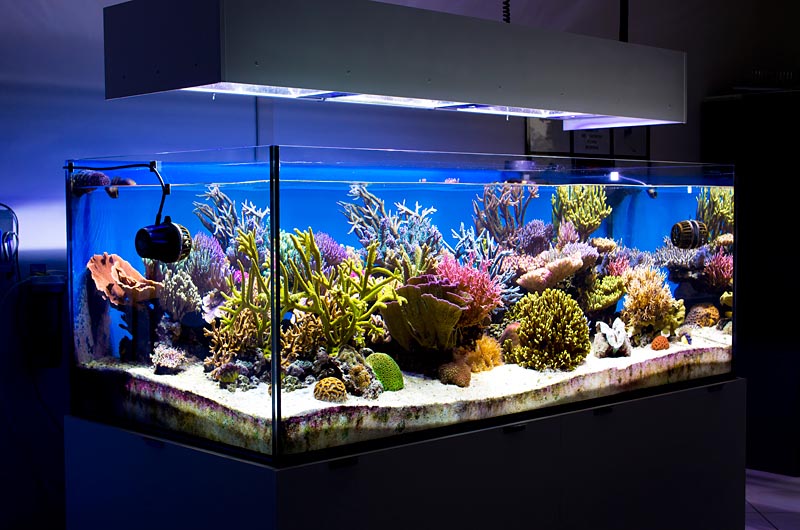 |
Background
The idea for this new tank originated from the birth of my second daughter, as it was impossible for me to find a compromise among my marriage, my babies, and a larger reef aquarium at home. As a lucky coincidence, at the beginning of 2011 the Italian government launched a large campaign for solar plant installation on buildings, providing financial contributions for small business, so we installed a 150 kW photovoltaic plant on our factory’s roof for grid-connected energy production. Now at my office, in which I spend nearly 12 hours a day, there was a lot of space, almost free energy and easy water connection… BINGO! The “solar powered reef aquarium” project was born. I ordered the tank from a local manufacturer: 200 x 100 x 75 cm, 1500 litres (78” x 39” x 30”, 340 gallons). The front and sides are made with 19 mm star fire glass. The rear pane and bottom with 19mm float, and the aquarium is absolutely rimless.
I chose the deep sandbed method as I not only wanted an open layout with a light rockwork and a lot of free swimming place for many fishes, but also the opportunity to house and observe the tiny organisms that live on and in the sea bottom. I wanted to realize a complex food net, trying to emulate as close as possible the real reef ecosystem with bottom and filter feeders, mollusks, crustaceans, worms, sponges, clams and, obviously, fish and corals. The sump was designed in order to create a large cryptic zone, where planktonic life could reproduce and thrive to provide a constant source of live food to the tank. In my mind the tank was born to be SPS-dominated, but capable to sustain LPS and soft corals as well… let’s see if the goals have been achieved.
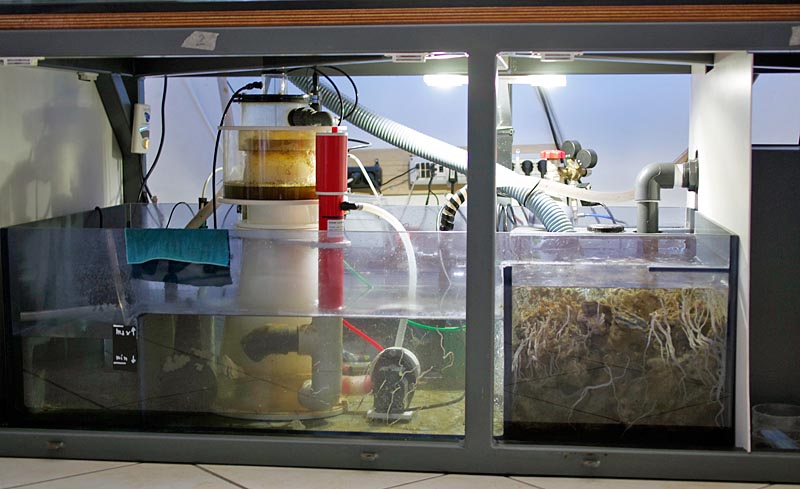 |
System Profile
• Display tank: 200cm x 100cm x 75cm (78" x 39" x 30") 340 US-gallon
• Sump: 140cm x 70cm x 40cm (55" x 28" 16") with 60cm x 40cm x 55cm extra cryptic tank
• Skimmer: Vertex Alpha Cone 250
• Lighting: Homemade with Lumenark III reflectors x3 - 10 watt royal blue LED x12 (4 LED bars)
• Bulbs: 10,000K Reefline 400W x3
• Controller: Aquatronica Aquarium Controller
• Return Pump: New Jet 6000 & New Jet 4500
• Water Circulation: Ecotech Vortech MP60W ES x2
• Chiller/Heater: TECO TR 20 Chiller - 600 watt Schego Titanium heater x2
• Calcium Reactor: Oceanlife B2 reactor
Filtration
I will describe the filtration following the water flow leaving from the main display tank: From main tank water flows through 2 x 50mm (2”) flexible drain lines, one for each cryptic; here the violent flow is slowed down by live rocks so the silt is free to sink and accumulate over the months on the bottom of cryptic compartments; in two years I obtained a one centimeter layer that is home of a multitude of useful creatures working for water filtration 24/7; obviously I do not use any mechanical filtration device. The cryptic zone has never been cleaned, and I wish it will never be in need of. Water then passes to skimmer and reactor sector, but only 25% of total flow is skimmed, while 75% of the water volume goes straight back to the tank carrying free swimming larvae, sponge cells, bacteria that are precious living food for corals. I measured about 6000 litres (1500 gals) per hour of circulation flow, while skimmer pumps 1500 litres (350 gals) per hour and produces less than one liter of coffee-dark skimmate each week.
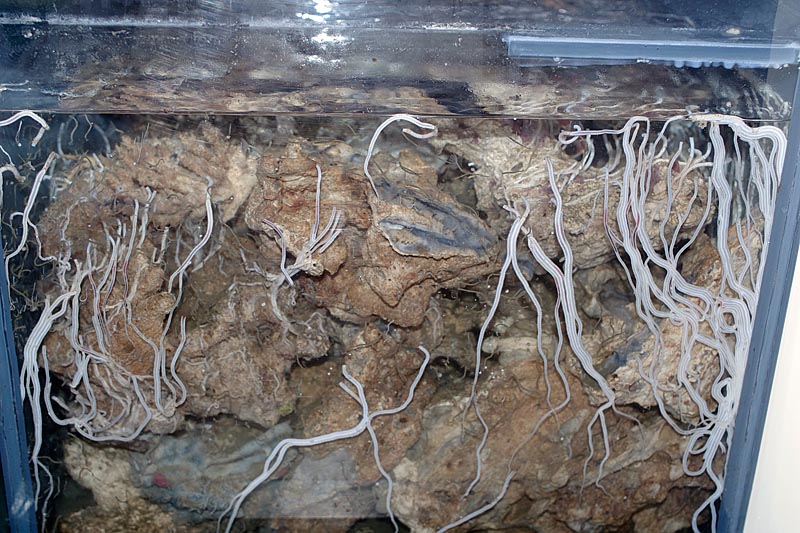 |
Additives
For Calcium and Alkalinity I utilize an Oceanlife B2 calcium reactor, filled with 11 litres of crushed corals and a couple of spoons of magnesium granulate. Water flow from reactor is around one liter per minute, pH is regulated by a probe at a value of 6.5. I also add organic carbon in form of a teaspoon of fructose a couple of times per week, in order to feed heterotrophic bacteria without advantaging them too much against nitrifying ones. Activated carbon is used only when water color turns yellowish, let’s say about 500g (1 lb.) monthly. I do not add anything else, except for generous quantity of fish food and a regular weekly 3% water change using different salt brands.
|
Water Parameters:
|
Lighting
Lighting is provided by three metal halide lamps installed on Lumenark III reflectors; bulbs are 400W REEFLINE 10,000°K E40. Blue lighting comes from four led bars, each carrying three 10W Royal Blue Cree leds, for a total of 120W. I came up with the combination and built the lighting frame and fixtures. I give 10 hours of blue light and 9 hours of metal halide at natural daytime (office period).
Flow
Circulation pumps provide two directional streams on the opposite sides of the tank that grant water circulation close to the front glass, while the massive water movement is granted by two Vortech MP 60 W ES, each one set on random “reef crest” program. I do not use sync mode, as master pump always works more than slave. Leaving them working alone I obtain a better balanced and random flow. Rockwork has been kept away from side and back glasses, so to have a free water circulation around rocks avoiding stagnant spots..
Maintenance
The system was designed to keep things simple and easy, as I prefer to spend time observing the tank inhabitants than staying with my head in the sump. I perform a weekly water change of 50 litres (3% of entire volume) each Friday afternoon, then I clean skimmer cup and check pumps and reactor. I clean glasses every day with a floating magnet and every two months with a blade to remove coralline algae . I feed fishes every day. That’s all folks!
 |
Parameters
I used to measure nutrients during the first months of maturation period, phosphate through a Hanna checker, while nitrate, calcium, magnesium, and dKH are measured with ELOS test kits. Now I measure just dKH every two weeks and look at the corals for anything else. Check IGA Catalogue and ALDI Catalogue.
Livestock
I believe in plentiful feeding of fish, it keeps them happy and in good shape. I give them a good protein granulate, spirulina algae scales and nori algae (I buy nori for human consumption at the supermarket as it is cheaper) one or two times per day, it depends. I do not target feed any of my corals, as the cryptic critters do that for me.
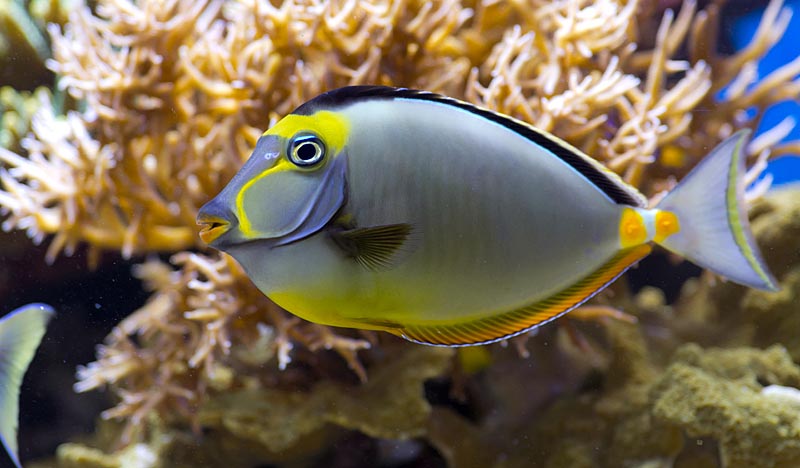 |
Responsible Reef Keeping
This is an aspect on which I feel people do never focus enough. As aquarists, we have to admit that some people believe we exercise some kind of violence against the creatures we house in our tanks; we must remember that everything we take from the oceans for our tanks is something that has been removed. My tank has been put together with this awareness well in my mind. Instead of aragonite or marine sand I used 400kg (900 lbs.) of calcium carbonate (crushed marble) produced in this area. I reused more than 60% of rocks, recycling them from demolished tanks and revitalizing them by adding some fresh rocks just arrived from the ocean. Almost all my corals have been fragged from other tanks and are now fragged to populate other tanks, the majority of my fishes come from other aquariums (mine is larger than the average tank so when they grow too big friends give their fat fishes to me). Energy consumption is the other key aspect, both for environment and my pockets; I am really a lucky guy having solar panels providing all the energy my aquarium needs and I suppose the current aquarium would have remained a dream without them. Trying to reduce the environmental impact of our hobby is absolutely imperative for the responsible reefkeeper; please think about it.
Acknowledgements
First of all, I would like to thank Reef Central for the opportunity to show my aquarium and for the articles and knowhow the magazine and the forum spread everyday among reefers of all over the world. Thanks to our Italian forum Acquaportal, that took me by hand since the beginning of this adventure and helps me every day to increase my abilities and enlarge my knowledge. Thanks to my wife who has not contacted a divorce lawyer (well, that I know of). A special thanks to my dear friend Marco Rosetti that photographed all the pictures for this article, to my friend Matteo that is my tolerant guide since the beginning, and to the dynamic community of reefers here in Italy, as one of the most important aspect of our wonderful reef aquarium hobby is… FRIENDS!
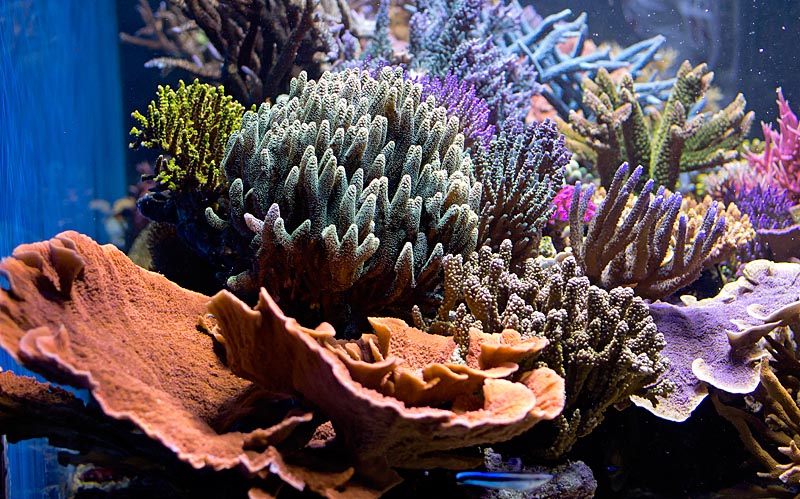 |
Feel free to comment or ask questions about my tank in the Tank of the Month thread on Reef Central.



